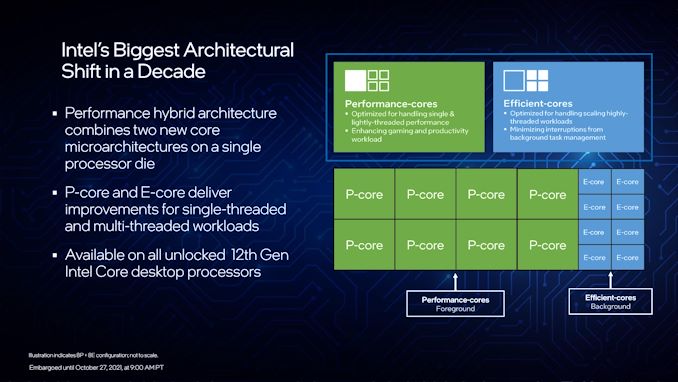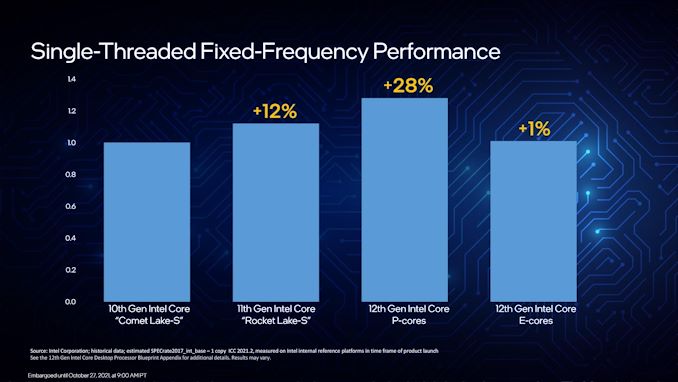Intel 12th Gen Core Alder Lake for Desktops: Top SKUs Only, Coming November 4th
by Dr. Ian Cutress on October 27, 2021 12:00 PM EST- Posted in
- CPUs
- Intel
- DDR4
- DDR5
- PCIe 5.0
- Alder Lake
- Intel 7
- 12th Gen Core
- Z690
A Hybrid/Heterogeneous Design
Developing a processor with two different types of core is not a new concept – there are billions of smartphones that have exactly that inside them, running Android or iOS, as well as IoT and embedded systems. We’ve also seen it on Windows, cropping up on Qualcomm’s Windows on Snapdragon mobile notebooks, as well as Intel’s previous Lakefield design. Lakefield was the first x86 hybrid design in that context, and Alder Lake is the more mass-market realization of that plan.
A processor with two different types of core disrupts the typical view of how we might assume a computer works. At the basic level, it has been taught that a modern machine is consistent – every CPU has the same performance, processes the same data at the same rate, has the same latency to memory, the same latency to each other, and everything is equal. This is a straightforward homogenous design that’s very easy to write software for.
Once we start considering that not every core has the same latency to memory, moving up to a situation where there are different aspects of a chip that do different things at different speeds and efficiencies, now we move into a heterogeneous design scenario. In this instance, it becomes more complex to understand what resources are available, and how to use them in the best light. Obviously, it makes sense to make it all transparent to the user.
With Intel’s Alder Lake, we have two types of cores: high performance/P-cores, built on the Golden Cove microarchitecture, and high efficiency/E-cores, built on the Gracemont microarchitecture. Each of these cores are designed for different optimization points – P-cores have a super-wide performance window and go for peak performance, while E-cores focus on saving power at half the frequency, or lower, where the P-core might be inefficient.
This means that if there is a background task waiting on data, or something that isn’t latency-sensitive, it can work on the E-cores in the background and save power. When a user needs speed and power, the system can load up the P-cores with work so it can finish the fastest. Alternatively, if a workload is more throughput sensitive than latency-sensitive, it can be split across both P-cores and E-cores for peak throughput.
For performance, Intel lists a single P-core as ~19% better than a core in Rocket Lake 11th Gen, while a single E-core can offer better performance than a Comet Lake 10th Gen core. Efficiency is similarly aimed to be competitive, with Intel saying a Core i9-12900K with all 16C/24T running at a fixed 65 W will equal its previous generation Core i9-11900K 8C/16T flagship at 250 W. A lot of that will be that having more cores at a lower frequency is more efficient than a few cores at peak frequency (as we see in GPUs), however an effective 4x performance per watt improvement requires deeper investigation in our review.
As a result, the P-cores and E-cores look very different. A deeper explanation can be found in our Alder Lake microarchitecture deep dive, but the E-cores end up being much smaller, such that four of them are roughly in the same area as a single P-core. This creates an interesting dynamic, as Intel highlighted back at its Architecture Day: A single P-core provides the best latency-sensitive performance, but a group of E-cores would beat a P-core in performance per watt, arguably at the same performance level.
However, one big question in all of this is how these workloads end up on the right cores in the first place? Enter Thread Director (more on the next page).
A Word on L1, L2, and L3 Cache
Users with an astute eye will notice that Intel’s diagrams relating to core counts and cache amounts are representations, and some of the numbers on a deeper inspection need some explanation.
For the cores, the processor design is physically split into 10 segments.
A segment contains either a P-core or a set of four E-cores, due to their relative size and functionality. Each P-core has 1.25 MiB of private L2 cache, which a group of four E-cores has 2 MiB of shared L2 cache.
This is backed by a large shared L3 cache, totaling 30 MiB. Intel’s diagram shows that there are 10 LLC segments which should mean 3.0 MiB each, right? However, moving from Core i9 to Core i7, we only lose one segment (one group of four E-cores), so how come 5.0 MiB is lost from the total L3? Looking at the processor tables makes less sense.
Please note that the following is conjecture; we're awaiting confirmation from Intel that this is indeed the case.
It’s because there are more than 10 LLC slices – there’s actually 12 of them, and they’re each 2.5 MiB. It’s likely that either each group of E-cores has two slices each, or there are extra ring stops for more cache.
Each of the P-cores has a 2.5 MiB slice of L3 cache, with eight cores making 20 MiB of the total. This leaves 10 MiB between two groups of four E-cores, suggesting that either each group has 5.0 MiB of L3 cache split into two 2.5 MiB slices, or there are two extra LLC slices on Intel’s interconnect.
| Alder Lake Cache | |||||||
| AnandTech | Cores P+E/T |
L2 Cache |
L3 Cache |
IGP | Base W |
Turbo W |
Price $1ku |
| i9-12900K | 8+8/24 | 8x1.25 2x2.00 |
30 | 770 | 125 | 241 | $589 |
| i9-12900KF | 8+8/24 | 8x1.25 2x2.00 |
30 | - | 125 | 241 | $564 |
| i7-12700K | 8+4/20 | 8x1.25 1x2.00 |
25 | 770 | 125 | 190 | $409 |
| i7-12700KF | 8+4/20 | 8x1.25 1x2.00 |
25 | - | 125 | 190 | $384 |
| i5-12600K | 6+4/20 | 6x1.25 1x2.00 |
20 | 770 | 125 | 150 | $289 |
| i5-12600KF | 6+4/20 | 6.125 1x200 |
20 | - | 125 | 150 | $264 |
This is important because moving from Core i9 to Core i7, we lose 4xE-cores, but also lose 5.0 MiB of L3 cache, making 25 MiB as listed in the table. Then from Core i7 to Core i5, two P-cores are lost, totaling another 5.0 MiB of L3 cache, going down to 20 MiB. So while Intel’s diagram shows 10 distinct core/LLC segments, there are actually 12. I suspect that if both sets of E-cores are disabled, so we end up with a processor with eight P-cores, 20 MiB of L3 cache will be shown.













395 Comments
View All Comments
Wrs - Saturday, October 30, 2021 - link
@Spunjii It's a detail I bother with. If two chips are equally performant at a fixed wattage, but one chip can sustain a higher wattage, then it is fair to deduce that chip as having more performance potential. This is something we'll have to dissect between ADL and Zen 3 of course. Their process nodes suggest they ought to be similarly efficient at fixed power, but there will be other factors as OS, different cores, and quantity of cache.@Oxford Guy The goalposts are moving. Any reputable $70 cooler is not outrageously loud. If you need extra quiet then you'll pay up or tweak the fans regardless of whether you got Zen 3 or ADL or RKL. I was just pointing out that Zen 3 has its own dissipation problems (due to design & build) that could set it back in performance on the same heatsink.
Wrs - Saturday, October 30, 2021 - link
Also, Noctua agrees with my findings. Here you can search a wide variety of processors they have tested with most of their coolers: https://ncc.noctua.at/cpus/model/Intel-Core-i9-129...According to Noctua, the vanilla U12S gets 3 bars for overclocking headroom on the 11700/11900k and 12700/12900k, but only 2 bars for Ryzen 3700x/5800x/5900x/5950x, despite all of us knowing how much more heat RKL dissipates compared to Zen 2/3. (Noctua has access to ADL samples that we don't.) The weaker thermal interface on the Ryzen MCMs is real; it wasn't just me misapplying thermal paste.
Oxford Guy - Sunday, October 31, 2021 - link
'The goalposts are moving. Any reputable $70 cooler is not outrageously loud.'Apparently. Somehow 'noisy' is not 'outrageously loud'.
Wrs - Sunday, October 31, 2021 - link
@Oxford If you have a problem with the design noise of $70 coolers or air cooling in general then say so lol. I'm just pointing out that at stock everything, a typical $70 tower cooler on a Ryzen 5800 or higher nets you maximum fan noise under full CPU load, even on an open bench, even as the heat pipes remain cool to the touch. That's a thermal conduction deficiency in the processor package.You can lower fan speeds, change out the fans, undervolt/throttle the processor. But that's true regardless of what CPU you got.
MaxIT - Friday, October 29, 2021 - link
Well, to be honest they are not speaking about TDP anymore. 241W is the peak power consumption under load, according to their data.DigitalFreak - Wednesday, October 27, 2021 - link
Man, the Intel fanbois are getting major boners over leaked synthetic benchmarks. They're so desperate they'll take anything they can get. Kinda like incels...Spunjji - Thursday, October 28, 2021 - link
Also like Incels: they project, constantly. Everything is always the fault of "AMD fanboys".Spunjji - Thursday, October 28, 2021 - link
blahpsychobriggsy - Thursday, October 28, 2021 - link
'destroy' is a bit strong.It looks like ADL will have the single core lead, and finally fixes Intel's multi-core problem. However it might not be by much, the power use looks like it will be higher, and there is the platform and DDR5 cost and early adopter issues.
AMD's big worry is the 12600KF, which may also perform excellently on DDR4 due to losing some cores. It might mean that the 12600KF solution exceeds the 5800X at a similar cost to the 5600X. AMD have had a while to think of a solution to this (IMO price reductions and a 105W higher-clocked version of the 5600X might help), but they might just release all this with the v-cache products in two or three months rather than rushing a band-aid out now.
drothgery - Thursday, October 28, 2021 - link
Intel has no intention of destroying AMD even if they could; keeping anti-trust lawsuits away is helpful. Keeping AMD in a position where they're forced to compete on value rather than performance, though, they're all for that.